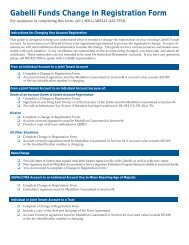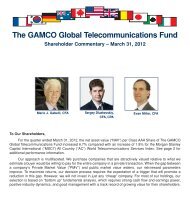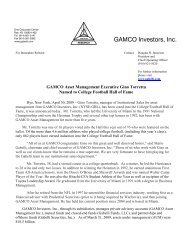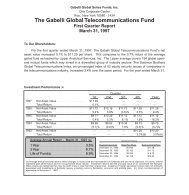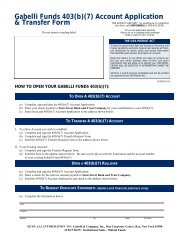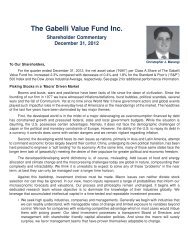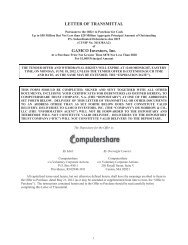Statement of Additional Info - Gabelli
Statement of Additional Info - Gabelli
Statement of Additional Info - Gabelli
Create successful ePaper yourself
Turn your PDF publications into a flip-book with our unique Google optimized e-Paper software.
GENERAL INFORMATION AND HISTORY<br />
The Trust is a diversified, open-end management investment company organized as a Massachusetts business trust on<br />
June 12, 1986. On September 7, 2012, the Trust’s Board <strong>of</strong> Trustees (collectively, the “Board” and individually, each a<br />
“Trustee”) approved a change in the name <strong>of</strong> the Trust from “The GAMCO Westwood Funds” to “The TETON<br />
Westwood Funds” and the names <strong>of</strong> each <strong>of</strong> the individual funds as follows: TETON Westwood Mighty Mites Fund,<br />
TETON Westwood SmallCap Equity Fund, TETON Westwood Income Fund, TETON Westwood Equity Fund, TETON<br />
Westwood Balanced Fund, and TETON Westwood Intermediate Bond Fund, effective on October 1, 2012. The TETON<br />
Westwood Mid-Cap Equity Fund commenced operations on May 31, 2013. The Trust operates a multi-class structure<br />
pursuant to Rule 18f-3 <strong>of</strong> the Investment Company Act <strong>of</strong> 1940, as amended (the "1940 Act").<br />
INVESTMENT OBJECTIVES AND MANAGEMENT POLICIES<br />
The Prospectuses discuss the investment objectives <strong>of</strong> each Fund and the principal strategies to be employed to achieve<br />
those objectives. This section contains supplemental information concerning certain types <strong>of</strong> securities and other<br />
instruments in which each Fund may invest, additional strategies that each Fund may utilize, and certain risks associated<br />
with such investments and strategies.<br />
The Funds, except for the Mighty Mites Fund and Mid-Cap Equity Fund, will not engage in the short-selling <strong>of</strong> securities.<br />
The Funds, except for the Mighty Mites Fund, will not engage in arbitrage. In addition, as a fundamental policy, the<br />
Funds will not issue senior securities (collateral arrangements with regard to initial and variation margin on futures and<br />
options transactions shall not be considered the issuance <strong>of</strong> a senior security), except as set forth under "Investment<br />
Restrictions" below.<br />
Convertible Securities (All Funds). A convertible security is a fixed-income security, such as a bond or preferred<br />
stock, which may be converted at a stated price within a specified period <strong>of</strong> time into a specified number <strong>of</strong> shares <strong>of</strong><br />
common stock <strong>of</strong> the same or a different issuer. Convertible securities are senior to common stock in a corporation's<br />
capital structure, but usually are subordinated to non-convertible debt securities. While providing a fixed stream <strong>of</strong><br />
income (generally higher in yield than the income derivable from a common stock but lower than that afforded by a<br />
similar non-convertible debt security), a convertible security also affords an investor the opportunity, through its<br />
conversion feature, to participate in the capital appreciation <strong>of</strong> the common stock into which it is convertible.<br />
In general, the market value <strong>of</strong> a convertible security is the higher <strong>of</strong> its "investment value" (i.e., its value as a fixedincome<br />
security) or its "conversion value" (i.e., the value <strong>of</strong> the underlying shares <strong>of</strong> common stock if the security is<br />
converted). As a fixed-income security, the market value <strong>of</strong> a convertible security generally increases when interest rates<br />
decline and generally decreases when interest rates rise. However, the price <strong>of</strong> a convertible security also is influenced<br />
by the market value <strong>of</strong> the security's underlying common stock.<br />
U.S. Government Securities (All Funds). Securities issued or guaranteed by the U.S. government or its agencies or<br />
instrumentalities include U.S. Treasury securities, which differ only in their interest rates, maturities, and dates <strong>of</strong><br />
issuance. Treasury Bills have initial maturities <strong>of</strong> one year or less; Treasury Notes have initial maturities <strong>of</strong> one to ten<br />
years; and Treasury Bonds generally have initial maturities <strong>of</strong> greater than ten years. Some obligations issued or<br />
guaranteed by U.S. government agencies and instrumentalities, for example, Government National Mortgage Association<br />
("GNMA") pass-through certificates, are supported by the full faith and credit <strong>of</strong> the U.S. Treasury; others, such as those<br />
<strong>of</strong> the Federal Home Loan Banks, by the right <strong>of</strong> the issuer to borrow from the U.S. Treasury; others, such as those issued<br />
by the Federal National Mortgage Association ("FNMA"), by discretionary authority <strong>of</strong> the U.S. government to purchase<br />
certain obligations <strong>of</strong> the agency or instrumentality; and others, such as those issued by the Student Loan Marketing<br />
Association, only by credit <strong>of</strong> the agency or instrumentality. While the U.S. government provides financial support to<br />
such U.S. government-sponsored agencies or instrumentalities, no assurance can be given that it will always do so since it<br />
is not so obligated by law. A Fund will invest in such securities only when it is satisfied that the credit risk with respect<br />
to the issuer is minimal.<br />
Recent Events Regarding FNMA and FHLMC Securities. On September 6, 2008, the Federal Housing Finance Agency<br />
(“FHFA”) placed FNMA (“FNMA”) and FHLMC (“FHLMC”) into conservatorship. As the conservator, FHFA<br />
succeeded to all rights, titles, powers and privileges <strong>of</strong> FNMA and FHLMC and <strong>of</strong> any stockholder, <strong>of</strong>ficer or director <strong>of</strong><br />
FNMA and FHLMC with respect to FNMA and FHLMC and the assets <strong>of</strong> FNMA and FHLMC. FHFA selected a new<br />
chief executive <strong>of</strong>ficer and chairman <strong>of</strong> the board <strong>of</strong> directors for each <strong>of</strong> FNMA and FHLMC. On September 7, 2008,<br />
the U.S. Treasury announced three additional steps taken by it in connection with the conservatorship. First, the U.S.<br />
3




